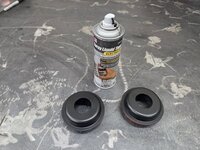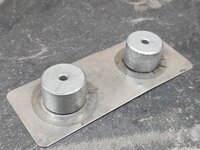I finally finished up my roll bar control arm sensors. For those who are not familiar, the early R129 cars use effectively a pair of limit switches on the rear lower control arms to identify when the rear suspension is at full extension. If it detects the suspension is at full extension while certain other conditions are present, like a tilt beyond a certain number of degrees, the car will decide it might be in danger of rolling over, so it will automatically deploy the roll bar. It does this by hydraulically retracting a retaining pin and allowing a spring loaded mechanism to be released which fully extends the roll bar in a fraction of a second.
The roll bar can be lowered again easily using a switch on the dash. It's not like a single use safety feature like an air bag. It can be deployed and reset indefinitely. That makes it kind of a fun game to see how many times I can get the roll bar to deploy while racing around off road. My record is 11 in one day. It certainly would have been more but on the 11th deployment I hit a rock and ripped both sensors off the car. If the car does not detect the sensors, the roll bar deploys and cannot be retracted.
The problem is that the control arm sensors sit on the bottom edge of the control arms and are plastic. They are a little delicate and extremely vulnerable.
Last year I destroyed two full sets of sensors off road. At about $200 per set for used sensors, that kind of sucks. So I decided to build my own.
I started by machining some solid steel housings to accept an off the shelf microswitch, which I mounted inside. I then made a solid steel arm that gets activated when the control arm is at full extension and acts on the microswitch. The key is that the arm is prevented from over extending and damaging the microswitch, so even if it gets hit, it will still work unless the solid steel arm gets badly bent.
If it does get damaged, I should be able to straighten or replace components fairly easily, and the microswitches are less than $5 each.

With that out of the way, I do have a few new problems that need attention.
First, the soft top does not work. For this I'm sure I'll just need to go through the system methodically to discover the problem. It's not magic. It'll either be a hydraulic issue or an electrical issue, and the WIS has detailed diagnostic procedures. I did notice a couple of leaking hydraulic cylinders in the rear. Last year I rebuilt a half dozen or so in the front half of the car. I didn't mess with the rear at that time though. Now the rears are leaking, so I'll probably just rebuild the rest while I'm going through it.
The second issue is a clunk somewhere in the drive train. My first guess is motor mounts. I installed new mounts last year, but they were cheap no name mounts. They don't appear to be leaking, but when I hammer the throttle there is a noticeable clunk as soon as the torque hits. This happens before the transmission gets a chance to downshift, so it's not related to trans shifting. It's a mount or bushing somewhere.
I'll do some more investigation this weekend. I suspect the 3.69 rear gears are essentially allowing a greater torque multiplication through the drive train, which applies an equal and opposite force back into the motor mounts and they are not able to adequately damp that movement.
If that is the case I'll probably look at either filling a set if mounts with urethane, or maybe just fabricating some custom mounts. For some of the custom 4x4s and hot rods I've built in the past I've just used generic rubber bushings and DOM tube for custom motor mounts. They wouldn't be as buttery smooth as factory hydraulic mounts, but they should be able to handle much more abuse.
I'm not sure what else could be causing the clunk. I've checked over all the bushings everywhere in the car and can't find any that look even a little questionable.
The last issue is a vibration under hard acceleration. It feels like maybe driveshaft. I installed new flex joints at both ends, so it's not likely to be those. The center bearing felt pretty good. The rubber bearing mount was a little more compliant than I would have expected, but not torn or anything. The u joint was a little notchy, but basically every MB u joint I've come across has been like that. Since the u joint never really flexes it will get stiff. None of the driveshaft components seem like a smoking gun. Not really sure what to do there.































